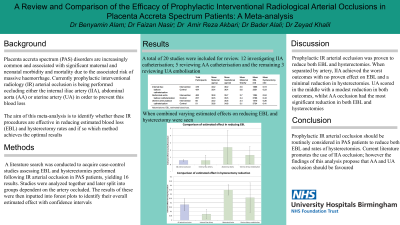Back

Women’s Health
009 - Comparing the efficacy of different methods of prophylactic arterial occlusion in PAS patients undergoing C-section

Purpose: PAS disorders are increasingly common and associated with significant maternal and neonatal morbidity and mortality due to the associated risk of massive haemorrhage. Currently prophylactic IR arterial occlusion is being performed occluding either the IIA, AA or UA in order to prevent this blood loss. The aim of this meta-analysis is to identify whether these IR procedures are effective in reducing EBL and hysterectomy rates and if so which method achieves the optimal results
Material and Methods: A literature search was conducted to acquire case-control studies assessing EBL and hysterectomies performed following IR arterial occlusion in PAS patients. Studies were analysed together and later split into groups dependent on the artery occluded. The results of these were then inputted into forest plots to identify their overall estimated effect with confidence intervals.
Results: Prophylactic IR arterial occlusion was proven to reduce both EBL and hysterectomies. When separated by artery, IIA achieved the worst outcomes with no proven effect on EBL and a minimal impact on hysterectomy rate with a only a 0.07 estimated effect. UA scored in the middle an estimated effect of 1.30 in EBL reduction and 0.26 in hysterectomy reduction. AA occlusion had the most significant impact, with an estimated effect of 2.40 in EBL reduction and 0.35 in hysterectomy reduction.
Conclusions: Prophylactic IR arterial occlusion should be routinely considered in PAS patients to reduce both EBL and rates of hysterectomies. Current literature promotes the use of IIA occlusion; however the findings of this analysis propose that AA and UA occlusion should be favoured
Material and Methods: A literature search was conducted to acquire case-control studies assessing EBL and hysterectomies performed following IR arterial occlusion in PAS patients. Studies were analysed together and later split into groups dependent on the artery occluded. The results of these were then inputted into forest plots to identify their overall estimated effect with confidence intervals.
Results: Prophylactic IR arterial occlusion was proven to reduce both EBL and hysterectomies. When separated by artery, IIA achieved the worst outcomes with no proven effect on EBL and a minimal impact on hysterectomy rate with a only a 0.07 estimated effect. UA scored in the middle an estimated effect of 1.30 in EBL reduction and 0.26 in hysterectomy reduction. AA occlusion had the most significant impact, with an estimated effect of 2.40 in EBL reduction and 0.35 in hysterectomy reduction.
Conclusions: Prophylactic IR arterial occlusion should be routinely considered in PAS patients to reduce both EBL and rates of hysterectomies. Current literature promotes the use of IIA occlusion; however the findings of this analysis propose that AA and UA occlusion should be favoured
